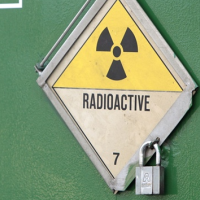Energy Department Considers Burying Nuclear Waste in 3-Mile-Deep Holes
 Credit: Kenzo Tribouillard/AFP/Getty Images
Credit: Kenzo Tribouillard/AFP/Getty Images
By Betsy Blaney, Associated Press
LUBBOCK, Texas — The federal government plans to spend $80 million assessing whether its hottest nuclear waste can be stored in 3-mile-deep holes, a project that could provide an alternative strategy to a Nevada repository plan that was halted in 2010.
The five-year borehole project was tentatively slated to start later this year on state-owned land in rural North Dakota, but it has already been met with opposition from state and local leaders who want more time to review whether the plan poses any public danger.
“It should be a statewide decision,” said Jeff Zent, spokesman for North Dakota Gov. Jack Dalrymple, adding that a resolution from state legislators is a possibility.
The Department of Energy wants to conduct its work just south of the Canadian border on 20 acres near Rugby, North Dakota — in part because it’s in a rural area not prone to earthquakes — but is prepared to look elsewhere if a deal can’t be reached. Some sites in West Texas and New Mexico have expressed interest in becoming interim sites for above-ground nuclear waste storage, but it’s not clear if they would be considered for borehole technology.
Project leaders say the research will require months of drilling deep into the earth but will not involve any nuclear waste. Instead, dummy canisters without radioactive material would be used in the project’s third and final phase.
“It’s to confirm the viability and concept,” said Robert J. MacKinnon, a technical manager on the project at DOE’s Sandia National Laboratories in Albuquerque, New Mexico.
The research team will look at deep rock to check its water permeability, stability, geothermal characteristics and seismic activity — a central concern with burying the hot radioactive waste deep underground.
If nearby earthquakes occur, the crystalline rock could slip and allow for water and radioactive material to migrate away from the site, said Stephen Hickman, director of the U.S. Geological Survey’s Earthquake Science Center.
Rugby site has very little seismic activity, he said.
If the technology proves successful and the government moves forward with the deep borehole disposal, there must be no fracking-related injection wells in the vicinity.
North Dakota was one of the country’s hot spots for fracking before the price of oil began to drop. Most of the fracking occurred in the state's western half, and there is no fracking done within about 75 miles of the project site near Rugby, which is in the eastern half of the state.
“That would also create a problem,” Hickman said of the injection wells, which some research has linked to seismic activity.
Currently, high-level radioactive waste — both from government sources and utilities’ nuclear power plants — is without a final burial site. The waste at power plants is stored on site in pools of water or in heavily fortified casks, while the government’s waste remains at its research labs.
The Department of Energy said even if deep borehole disposal were to be greenlit and become reality, it would still want to construct a traditional geologic repository that could replace the proposed Yucca Mountain site.
But the 16,000-foot-deep boreholes could be used for high-level radioactive waste from the department’s decades of nuclear work originally slated to go to Yucca, including nearly 2,000 canisters of cesium and strontium now being stored in water at the department’s Hanford Site in Washington state.
An independent federal oversight agency charged with examining how nuclear waste is handled has concerns the project will distract the department from pursuing another project similar to Yucca.
And state and local officials aren’t gung-ho about the $35 million borehole project’s first phase being in their backyard.
Duane Johnston is on the Pierce County Commission. He said he doesn’t entirely trust the government.
“Sure it’s an experimental, we know that,” Johnston said. “But it could be suitable for nuclear waste. That’s what bothers us. You never know about the government.”
Earlier this month, Pierce County officials discussed the issue with the governor and state attorney general, with the county commission ultimately placing a moratorium on the project. The commission says it and the county’s planning board must agree before the freeze is lifted.
The county is holding a public hearing Tuesday in Rugby, a community of about 3,000 people 15 miles north of the site.
DOE spokesman Bartlett Jackson said options for alternative locations would be explored if the Rugby site isn’t available.
To Learn More:
$4.1 Million Settlement Vindicates Nuclear Waste Plant Whistleblower (by Steve Straehley, AllGov)
The Nuclear Waste Leak in New Mexico…Maybe It Wasn’t the Kitty Litter After All (by Noel Brinkerhoff, AllGov)
New Mexico Fines U.S. over Nuclear Waste Violations (by Danny Biederman and Noel Brinkerhoff, AllGov)
Six Underground Tanks Leaking Nuclear Waste in Washington State (by Noel Brinkerhoff and Danny Biederman, AllGov)
- Top Stories
- Unusual News
- Where is the Money Going?
- Controversies
- U.S. and the World
- Appointments and Resignations
- Latest News
- Musk and Trump Fire Members of Congress
- Trump Calls for Violent Street Demonstrations Against Himself
- Trump Changes Name of Republican Party
- The 2024 Election By the Numbers
- Bashar al-Assad—The Fall of a Rabid AntiSemite






Comments